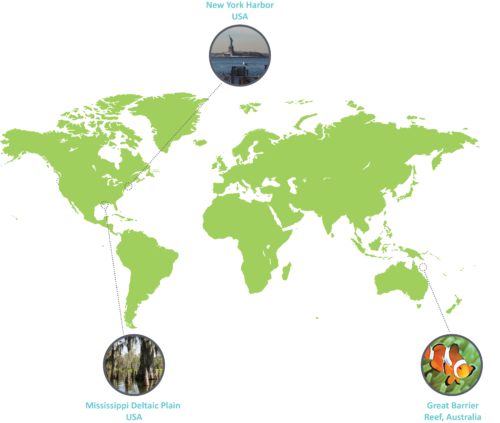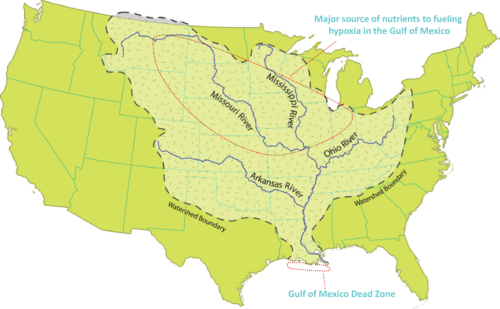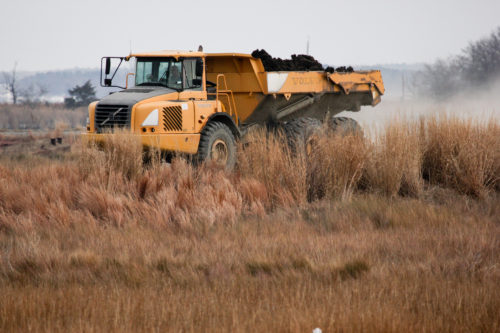You’ve got to crack a few eggs to make an omelet: Balancing differing worldviews and appealing to stakeholders in environmental management
Dylan Taillie, Annie Carew ·This past week in our Science for Environmental Management class, students read about three case studies on large, complex ecosystems: New York Harbor, the Mississippi Deltaic Plain and the Great Barrier Reef.

Although varying systems, we found commonalities in the issues that many of them face and these commonalities framed much of our discussion throughout class.
As always, our conversation varied, and this class we began by going into some detail about the complexities of modeling whole systems, as well as solely hypoxia modeling. The George Box quote “all models are wrong, but some are useful” is a recurring theme in our discussions of models, especially data-strained models such as the estimation of the Gulf of Mexico dead zone using a single survey each year1,2. Models can be incredibly useful, but are only one piece of the puzzle when studying large ecosystems, and once models are understood they must be integrated and applied to further research, monitoring, and policy.
The topic of the Gulf’s massive dead zone brought up two concepts that I would like to concentrate on during this blog. As managers and scientists, we are often tasked with the difficult prospects of:
- Engaging stakeholders who don’t necessarily value the resource or ecosystem we are looking to protect, and
- Finding consensus with stakeholders that have differing worldviews and values.
The Gulf of Mexico dead zone, for example, is fueled by nutrients from states in the Midwest. Farmers and businesses in these states, however, have no incentive to contribute resources for the creation of wetlands in Louisiana that would take up the nutrients (and sequester carbon) that farms are depositing into tributaries of the Mississippi. Therefore, the burden falls on Louisiana to fund the creation of more wetlands that would mitigate the effects of nutrients from upstream.

One way to potentially solve this problem is through regulation using a cap and trade market for nutrients or carbon. If this regulation is not likely to be implemented, however, we as environmental managers must think of creative ways to incentivize people in the Midwest and Louisiana to care about the creation of mangroves and wetlands in the Mississippi Deltaic Plain. Could the loss of homes due to flooding from reduced wetlands appeal to the emotions of farmers in the Midwest? Could a tax on seafood shipped from the gulf to Midwest states be levied to monetize the effect that nutrients have on ecosystems in the delta? Is there a common currency (not necessarily in dollars) that farmers in the Midwest may value that may become scarce in the near future? There is obviously not a definite solution to this, but there are lots of possibilities and unique ways of tackling problems created by an action elsewhere that have adverse effects on ecosystems far away.
The dead zone in the Gulf is just one example of the need to seek collaborative and forward-thinking solutions when regulation is not likely. We face a similar problem here in the Chesapeake Bay with nutrients from Pennsylvania being transported by the Susquehanna River. A recent STAC seminar given by Jim Boyd of Resource’s for the Future discusses different ways of valuing ecosystem services in the Chesapeake Bay Region.
When possible, scientists and managers seek solutions that mitigate consequences for all parties involved in a management action. A best-case scenario is a win-win, where all ‘sides’ of an issue come out with some benefit. One example of a win-win is the use of dredge material from outside of Baltimore harbor to reinforce Poplar Island, giving industry a cheap place to dispose of dredge material and creating robust nesting areas for native birds3.

However, most environmental management solutions usually don’t work out as well as the Poplar Island example. Most often the case is that some eggs need to be broken in order to make an omelet (that is, some parties involved need to make concessions in order to reach a consensus). Although this is a metaphor, it is important to note that when making an omelet, only the shell of the eggs is discarded; the yolk and egg white are repurposed and often times some cheese and bacon are added to sweeten the deal. I would like to think of the shell as the preconceptions and convictions of stakeholders that come together to seek a solution. It is healthy to discard these, and can allow someone like a scientist to step into a waterman’s boots, a fisherman to have an open mind about the future benefits of stricter regulations that may damage him economically in the short run, and a systems modeler to work on their communication skills so that they can work more cohesively with a policy maker. The mixing up of the eggs could be the reconfiguring of the original goals that each party came in with, and the addition of cheese could be the search for innovative solutions like the one on Poplar Island.
When managing large, complex systems such as the Mississippi Deltaic Plain or the Great Barrier Reef, it is next to impossible to walk away with win-win solutions all around. This is why it is important that the process begin with stakeholders and managers of all walks, and an understanding that there is some give-and-take involved in working towards innovative solutions.
References:
1. Box, G. E. P., and Draper, N. R., (1987). Empirical Model-Building and Response Surfaces. John Wiley & Sons, New York, NY.
2. Rabalais, N. N. Turner, E. R. Wiseman, W. J., (2002). Gulf of Mexico Hypoxia, A.K.A. “The Dead Zone”. Annual Review of Ecology and Systematics Vol. 33:235-263.
3. Erwin, M. R., Miller, J., and Reese J. G. (2007). Poplar Island Environmental Restoration Project: Challenges in Waterbird Restoration on an Island in Chesapeake Bay. Ecological Rest. December 1, 2007 vol. 25 no. 4 256-262.
Next Post > Talking about Transdisciplinary research in Paris
Comments
-
Ana Sosa 8 years ago
I think it is important, while talking to stakeholders and all people involved, to keep in mind that everybody has a different point of view. It is important to keep an open mind and try to sympathize with our audience when communicating science. We can surely all relate and find a common currency!
-
Ginni La Rosa 8 years ago
I was unable to attend last week's meeting, so this blog entry did a great job of providing me with a summary of how discussion went. Compromise is certainly one of the common themes in our class conversations. I like the new perspectives on the egg metaphor as well! I am glad to have had the chance to visit Poplar Island, and to this day I am impressed by its scale in both size and temporal planning. It is certainly covering new ground (pardon the pun) in terms of restoration research applications.
-
Hao Wang 8 years ago
We really need to make a balance between the different groups and attract those who opposite us. It is not an easy job in environment management.
-
Annie Carew 8 years ago
I thought what you said about including stakeholders' interests was particularly well-said. We have talked a lot about that, and will continue to talk about it until the end of the semester.
I also love the title of this blog, and you did an excellent job incorporating references and background information.
-
Stephanie 8 years ago
I think you did a great job of keeping your explanation of what can be a very triggering and politically charged aspect of policy making both neutral and simple. People can sometimes be too eager to wear our colors and loudly and proudly define our stances without care if that is clearly displayed in our writing. Reading your blog, however, I am unsure of your stance, which is a relief. It makes your unbiased language of your explanations make you a fair and reputable source of information.
-
Jake Shaner 8 years ago
Like the the use of the egg metaphor, but should have read it after dinner...On a more sincere note, I like your conclusion and feel that your final point about compromise is something that is often forgotten. If every stakeholder was a bit more willing to give up some ground, the eventual solution might end up better for all in some way. Reminds me of paying taxes (guess its the time of year) - I don't particularly like it, but I like clean drinking water and paved roads to drive on, among other publicly funded things.
-
Kavya Pradhan 8 years ago
Great job on the blog! I really appreciate the egg/omelet analogy, especially the part about discarding the preconceptions and conceptions of various stakeholders and coming together to convert the humble egg into a refined and balanced omelet. I still think that this is a win-win situation, as long as various stakeholders are willing to concede that the eggshells weren't necessary to begin with.
-
Hadley McIntosh 8 years ago
Great blog on our discussion last week. I think you really highlighted the problems that the Gulf Coast states are facing due to choices by individuals or corporations in the Midwest and Bread basket states. There will be many ideas put on the table regarding the Gulf coast restoration and finding answers to these questions (i.e. who will pay for relocation of coastal communities or if taxes could be implemented for restoration) will be our contribution to improving the environment and societal concerns.
-
Alterra Sanchez 8 years ago
Great job Dylan and Annie! The reason that the dead zone exists in the Gulf is largely due to actions in faraway states. This really makes me wonder why, though we are one country, there are not nationwide, federal regulations that are in place to protect the ENTIRE country's natural resources. It is so odd to me that this is allowed; we are so divided that states in one country are not concerned about the other states.... Also, amazing explanation of the egg metaphor! That is one tasty science omelette!
-
Katie Martin 8 years ago
I like the case study map you put together. Management must begin with stakeholders, but how can management occur when the problem is so distant from the affected stakeholders? Unaffected states need to be motivated to change policies. You make some great suggestions for how to accomplish this, but I think regulation first needs to come from the federal level.

